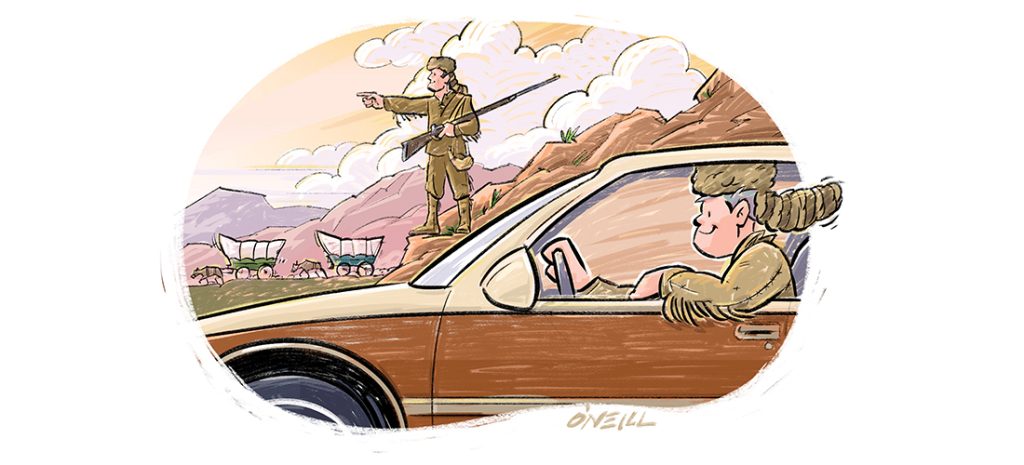Simple Life

One Journey Ends, Another Begins
Lessons from the road long ago taken, but not forgotten
By Jim Dodson
In ancient Roman religion, the god Janus was a two-faced chap revered as the deity of doorways and transitions, endings and new beginnings — hence the origin of this month’s name, signaling a moment when we wisely take time to reflect on where we’ve come from and what may lie ahead.
This year, this notion has fresh relevance to me.
Sometime this spring, assuming the good Lord is willing and the creek don’t rise, as my Southern granny liked to say, I hope to finish writing a book that means the world to me.
It’s about the legendary Great Wagon Road, described by historians as the most traveled road of colonial America, the country’s first immigrant “highway” that passed through the Appalachian backcountry from Philadelphia to Georgia, bringing tens of thousands of Scots-Irish, German and other European settlers to the American South, including my ancestors and quite possibly yours.
Joe Wilson, the great historian of American roots music, once estimated that “a quarter of Americans today have an ancestor who traveled the Great Wagon Road. You can still see traces of it, a track across high ridges, a trough through piney woods, guarded by wild turkey and chipmunks, a road that was in use for a century — the most important road in American history.”
Six years ago, an idea nurtured since I was knee-high to a historic roadside marker was born anew. With some encouraging research in hand, I paid a visit to a former Navy engineer named Tom Magnuson who heads up the Trading Path Association, based in Hillsborough, where my own Scottish ancestors arrived in the mid-1700s. Magnuson’s marvelous organization researches and documents America’s historic lost roads in order to preserve and expand public appreciation of them. I figured if anyone could tell me if it was feasible or pure folly to try to find the original roadway and follow it from Philly to Georgia 250 years after the fact, that fellow was Tom Magnuson.
My timing couldn’t have been better. He pointed out that recent scholarship by an army of historians, state archivists, archeologists and ordinary history nerds like me had actually determined the original path of the Great Wagon Road and even posted an exquisitely detailed description of its route through some of the most hallowed places in America.
“The Great Wagon Road,” Tom said, when I mentioned my objective, “is the grandaddy of America’s frontier highways — our creation myth, if you like — one that explains the origins of our national story better than any other. The people and ideas that came down that road shaped the character of this nation, both good and bad. That defines who we are today.”
This was all the encouragement I needed. Not long afterwards, I plotted my route and even purchased my very own “Great Wagon” for the journey — a 1996 Buick Roadmaster Grand Estate station wagon, said to be the last “true” American station wagon before Detroit switched to making SUVs.
I envisioned a pleasant three-week cruise along the winding 845-mile road in which I would encounter all sorts of interesting characters, local experts and fellow Wagon Road flamekeepers who shared my passion for this once lost frontier highway and its unique role in shaping America.
God laughs, as the ancient proverb goes, when grown men make plans.
In fact, the journey took five years and 2,100 miles to complete, in part due to the incredible amount of history, marvelous people and stories I found along the way, but also because a worldwide pandemic struck in the middle stages of my research, knocking me off the road for almost two years.
Certain moments stand out, including meeting descendants of Founding Fathers and Daniel Boone; sitting with a fabled Lincoln historian during the annual reading of the Gettysburg Address; walking Antietam with the National Park Service’s first female battlefield guide; and playing guitar with an Appalachian bluegrass legend.
All told, I visited with — and interviewed — more than 100 extraordinary and ordinary folks from every walk of life who had their own love affair with the old road.
I cherish their diverse voices on my iPhone recorder because they belong to a wonderfully democratic mix of experts and colorful characters, activists and local historians, thoughtful museum curators, gifted poets and preachers, artists and war re-enactors, history nuts of every political persuasion and kind strangers whose names I simply forgot to write down.
In the end, listening to their stories about an old road that has gripped my imagination since I was a kid standing in front of a huge covered wagon in a museum brought me even closer to the country I love.
It taught me how amazingly far we’ve come — and have yet to go.
Somehow, I think the god Janus would approve. PS
Jim Dodson can be reached at jwdauthor@gmail.com.
